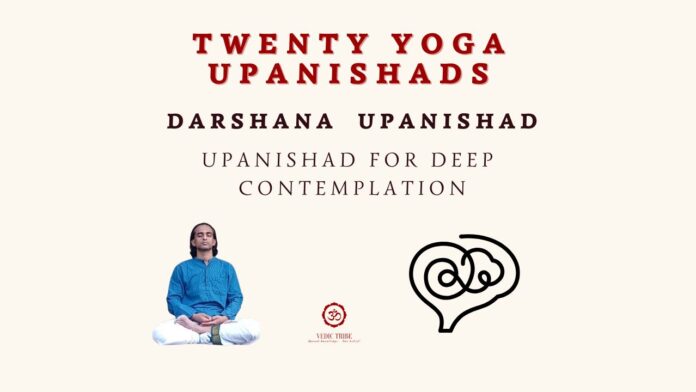Upanishad for deep contemplation:
In the previous article, we discussed the Yogakundalini Upanishad. In this article, we will discuss Darshana Upanishad.
Out of twenty Yoga Upanishads, seventeen are part of either Yajurveda or Atharvaveda. Only three are part of Samaveda; i.e., Dhyanabindu Upanishad, Yogachudamani Upanishad and Darshana Upanishad. Which means in ancient times, Rishis could sing this Upanishad. However, the such ancient knowledge is now forever lost.
Darshana Upanishad discusses – Nadis (channels of energy in the body), Ashtanga Yoga (similar to the later – Patanjali Ashtanga Yoga), Nine Asanas (Swastika, Gomukha, Padma, Vira, Simha, Bhadra, Mukta, Mayura and Sukha…etc.
Deities presiding over Nadis:
This Upanishad provides a valuable knowledge on the deities presiding over channels of energy.
Shiva – Sushumna Nadi
Hari – Ida Nadi
Brahma – Pingala Nadi
Viraj – Saraswati Nadi
Pushan – Pusha Nadi
Vayu – Varuna Nadi
Varuna – Alambusa Nadi
Annapurna – Kuhu Nadi
Chandra – Gandhari Nadi
Chandra – Shankini Nadi
Prajapati – Payasvini Nadi
While working with the energies of the bodies (Pranas), energy channels (Nadis) and energy centres (chakras), this knowledge of deities become very important. By meditating upon these deities, we can avail their blessings which will push our spiritual practices to new heights.
Internal pilgrimage:
Upanishad provides list of pilgrimage within the microcosm:
Sri-parvat – in crests (muscles attachment to the bone)
Kedara – in the forehead
Kuru-kshetra – in the chest
Prayaga – in the lotus of the heart
Chidambaram – in the middle of the heart
Kamalalaya – in Muladhara.
Pranayama model:
The Upanishad explains a pranayama model of 16 + 64 + 32.
– Inhalation from only left nostril for 16 seconds + holding the breath for 64 seconds + releasing the breath through right nostril for 32 seconds.
– Then, inhaling only from right nostril for 16 seconds + holding the breath for 64 seconds + releasing the breath through left nostril for 32 seconds.
– This one cycle will require 224 seconds or roughly four minutes.
Key takeaways:
– Study this Darshana Upanishad and adopt its teachings in your practice of Pranayama
– Meditate upon the presiding deities of Nadis and seek their blessings before starting your Pranayama.
In the next article, we will discuss – “Maha-vakya Upanishad”.
Madhwesh K
Vedic Tribe

